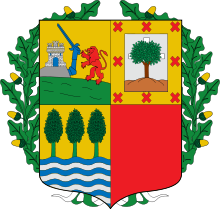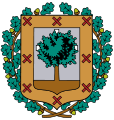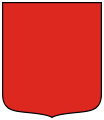- Coat of arms of the Basque Country
-
The current Basque coat of arms (Spanish: Escudo del País Vasco, Basque: Euskal autonomi erkidegoaren armarria[1]) is the official coat of arms of the Basque Country, Autonomous community of Spain. It consists of a party per cross representing the three historical territories of Álava, Gipuzkoa and Biscay, as well as a fourth, void quarter. The arms are ringed by a regal wreath of oak leaves, symbolic of the Gernikako Arbola. The fourth quarter once constituted the linked chains of Navarre; however, following a legal suit by the Navarre Government claiming that the usage of the arms of a region on the flag of another was illegal, the Constitutional Court of Spain ordered the removal of the chains of Navarre in a judgement of 1986.[2][3]
Contents
Origin
In 1936, the Provisional Government of Euzkadi, presided over by the first president, José Antonio Aguirre, adopted a shield with the arms of the three provinces of the Basque Country and those of Navarre. The president of the government affirmed in the preamble to the Decree of 19 October 1936, and thereby approved, the emblem and flag that was to be used by the Basque Country. Thus the shield of the Government of Euzkadi contained the arms of Álava, Gipuzkoa, Biscay and Navarre in a single blazon of four quarters surrounded by a crown of oak leaves. The Provisional Government of Euzkadi stated that "the flag must be that which gathers Basque unity and which the use, ever more frequent in the Basque lands, has sanctioned as such symbol of their unity."[4]
This shield, like the rest of the autonomous communities, disappeared after the pro-Franco victory in the Spanish Civil War. However, on 2 November 1978, the Consejo General del País Vasco (General Council of the Basque Country), restored the republican shield, albeit modified as follows:
- The Álava quarter lost the motto "En aumento de la justicia contra malhechores"[5] and both the designs of the castle and of the arm with sword were changed. The castle is now on top of a grey rock and the arm and sword are light blue in colour.
- In the Biscay quarter, the wolves of the arms of the Haro family were suppressed in 1986 and the field changed from gules to argent, the bordure from argent to gold, the crosses from sinople to gules, and the ground (terrase) from sinople to maroon.[6][7][8][9]
- In the Gipuzkoa quarter, the field changed from argent to gold, and the ground (terrase) was removed, leaving only the trees and the waves.[10][11]
- The fourth quarter once contained the linked chains of Navarre; however, following a legal suit by the Navarre government claiming that the usage of the arms of a region on the flag of another was illegal, the Constitutional Court of Spain forced the Basque government to remove the chains of Navarre, leaving the red background.[12]
In 1991 the Basque Government standardised the colours used in the shield.[13]
The Basque nationalist parties use an unofficially recognised Basque coat of arms, the Zazpiak Bat. It differs from the original one by being divided into six squares and by including the coat of arms of the Basque regions in France.[14]
The quarters
-
The arms of Álava are symbolic of the province's independence, with the dexter arm ready to fight its enemies.[15]
-
The Gernikako Arbola is depicted in the arms of Biscay as a testament to its importance.[16]
-
In the arms of Guipuzcoa the champagne symbolises the Bay of Biscay and the trees the tripartite division of the province.[15]
See also
Notes
- ^ "Euskalerriko Armak eta Banderak" (in Basque). Archived from the original on 2007-11-17. http://web.archive.org/web/20071117044350/http://es.geocities.com/aingast/index23.htm. Retrieved 2007-09-29.
- ^ Muñoz, Oscar Sánchez. "Sentencia TC 94/1985, de 29 de julio" (in Spanish). Materiales de Derecho Constitucional. http://www.der.uva.es/constitucional/verdugo/stc94_1985_autonomico.html. Retrieved 2007-09-29.
- ^ "Consejo General del País Vasco. ACUERDO de 13 de Noviembre de 1978 de adopción del emblema de Euzkadi." (in Spanish). http://www.euskadi.net/cgi-bin_k54/bopv_20?c&f=19781201&a=197800091. Retrieved 2007-09-29.
- ^ Santiago, Dotor (1998-10-28). "Coat-of-Arms (Basque Country, Spain)" (in English). CRW Flags. http://www.crwflags.com/fotw/flags/es)pv.html. Retrieved 2007-10-15.
- ^ "Armas de la Hermandad de Álava" (in Spanish). Archived from the original on 2007-06-12. http://web.archive.org/web/20070612025124/http://es.geocities.com/aingast/index233.htm. Retrieved 2007-09-29.
- ^ "Armas de la Provincia de Vizcaya" (in Spanish). Archived from the original on 2007-11-13. http://web.archive.org/web/20071113025200/http://es.geocities.com/aingast/index231.htm. Retrieved 2007-09-29.
- ^ "Vizcaya retoca su escudo" (in Spanish). Noticias de protocolo. http://noticiasprotocolo.blogspot.com/2007/03/vizcaya-retoca-su-escudo.html. Retrieved 2007-09-29.
- ^ "Escudo de Vizcaya" (in Spanish). http://personal.telefonica.terra.es/web/vizcayamedieval/armas.htm. Retrieved 2007-09-29.
- ^ "Iconografía de los Señores de Vizcaya en el siglo XIII" (in Spanish) (PDF). http://www.euskomedia.org/PDFAnlt/riev/22542554.pdf. Retrieved 2007-09-29.
- ^ "Armas de la Provincia de Guipúzcoa" (in Spanish). Archived from the original on 2008-01-05. http://web.archive.org/web/20080105085823/http://es.geocities.com/aingast/index232.htm. Retrieved 2007-09-29.
- ^ "Escudo y bandera del territorio histórico de Guipúzcoa" (in Spanish). Juntas Generales de Gipuzkoa. http://w390w.gipuzkoa.net/WAS/CORP/DJGPortalWEB/territorio_historico_de_gipuzkoa.jsp?id=02&idioma=es. Retrieved 2007-09-29.
- ^ "Ajuria Enea retira las cadenas de Navarra de su escudo" (in Spanish). El Mundo. http://www.elmundo.es/2000/10/06/espana/6N0076.html. Retrieved 2007-09-29.
- ^ "DECRETO 690/1991, de 17 de diciembre, por el que se regulan las especificaciones técnicas y la utilización de los elementos gráficos de identidad visual del Gobierno Vasco." (in Spanish). http://www.euskadi.net/cgi-bin_k54/ver_c?CMD=VERDOC&BASE=B03J&DOCN=000011646&CONF=/config/k54/bopv_c.cnf. Retrieved 2007-09-29.
- ^ Lee Rasmussen, Irene. "A Picture Speaks A Thousand Words: An Analysis of Terrorist Emblems" (in English) (PDF). University of Saint Andrews. p. 4. Archived from the original on April 14, 2006. http://web.archive.org/web/20060414082446/http://www.st-andrews.ac.uk/~ilr/emblems/mlittpdf/eta.pdf. Retrieved 2007-09-29.
- ^ a b "Aquitaine - Chapter 18". Archived from the original on October 10, 2007. http://web.archive.org/web/20071010012701/http://perso.numericable.fr/~briantimms/chf/18aquitaine.htm. Retrieved 2007-10-15.
- ^ Olsen, Brad. "Sacred Places Europe: 108 Destinations". CCC Publishing. http://books.google.com/books?id=cdM3qHlNeb4C&pg=PA289&lpg=PA289&dq=symbolism+%22arms+of+biscay%22&source=web&ots=8Kj6o9VM9B&sig=hzZiORhhdnUUPwule3D4YDk7w9w#PPA289,M1. Retrieved 2007-10-15.
Coats of arms of Spain Autonomous communities Andalusia • Aragon • Asturias • Balearic Islands • Basque Country • Canary Islands • Cantabria • Castile-La Mancha • Castile and León • Catalonia • Extremadura • Galicia • Community of Madrid • Region de Murcia • Navarre • La Rioja • ValenciaAutonomous cities Royal Family Categories:- Coats of arms of provinces and states
- Basque history
- Spanish coats of arms
Wikimedia Foundation. 2010.






